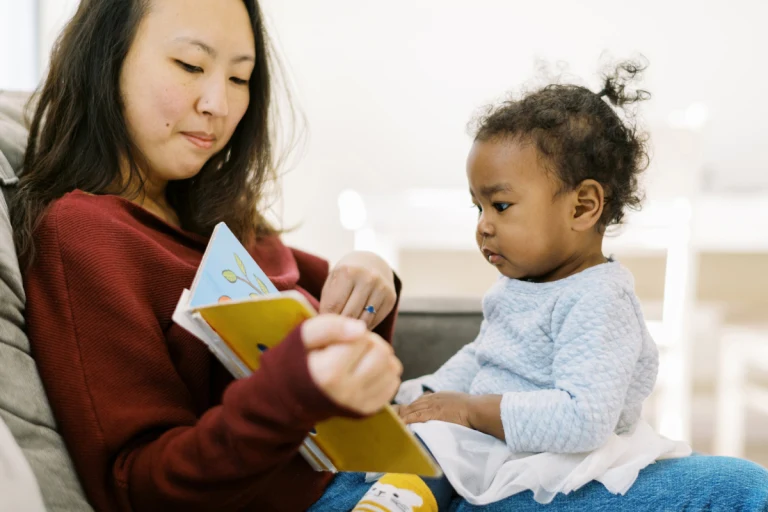
Around thirty-eight to forty weeks of journey of both father and mother with lots of excitement and overwhelming you both bring out a baby into this wonderful world. Some parents prepare themselves by reading books, attending workshops, seminars whereas others are still new to the whole concept of bringing up a baby. Knowing nothing to do or having doubts about how to talk to the baby? What to say? And what or how to play? While others think that will my baby understand what I say or is it just about drinking milk, sleeping and crying.
But there is lot more than drinking, sleeping and crying. From the time of baby being in mother’s womb there is a lot of development happening in the areas of organs, physical changes, gender assigning, emotion, senses and language development. Hence, the stimulation of the baby starts way before the baby is born.
For us to understand this let us look into some of the development that happens in the mother’s womb. There are three stages of development: germinal, embryonic and fetal stage. In germinal stage there is implantation of blastocyst, and it is the shortest stage. In embryonic stage structures such as bran, spinal cord, head, eyes, mouth, legs and arms are formed. Around five to six weeks your baby will have pulse, where the heart is beginning to form. In the final stage that is fetal stage the baby is assigned gender; things like fingernails, eyelashes and hair grows. Majority of the development happens in this stage like closing and opening of fists, all the systems are functioning, your baby can yawn, suck thumb, stretch and make faces.

Around week 18 the baby may wake up for the loud noises if asleep. Week 20- 21 the baby starts to develop five senses and can respond to sounds by moving or increasing its pulse. Week 29 to 32 brain develops more rapidly in these weeks study shows that the baby listens to mother’s talk, and this is observed at birth when the baby hears their mother’s voice.
By understanding these developments, we now can know what our babies are capable of while they are born. Cause the development happens way before the baby is born so does the stimulation in areas of hearing and language has to be considered something urgent and the parents to become has to start right from the time that baby is the mother’s womb. If you have missed out on it then you’ll have start it right from the day one of your baby is born.
After understanding what happens to baby you might want to help your baby and start stimulating it but if you are stuck with what to do? How to do? What are the benefits by stimulating your baby at a very early stage of life? Below are all the answers to your questions. First of all, let’s understand what early stimulation is, it simply means the activities and actions that we do that our baby develops various abilities of skills in language, listening, cognitive, motor and social. Scientists have concluded that the activities that we do are effective when there are neural connections. So, this happens around birth to 6 years of age and its always better to start stimulating your child as early as possible.
Here are few activities that we as parents to be can do when your baby is still in the womb around 16- 8 weeks as the baby hears mother’s voice – the mothers can read books such as story books, novels, holy scriptures or mythological stories and talk to your baby by expressing your love towards the baby. Around 20 weeks, you baby has started to respond to external sounds now the father, mother, baby’s sibling, grandparents can pitch in to by reading books, rubbing around the mother’s tummy as you feel the movements of the baby or give a nudge whenever you feel the kicks or see it. And talking about the excitement that you all are in to see the baby. These can be done while the baby is still in the womb. You can give create playlists of music or songs and play these to your baby.
In case if you have missed doing these when you baby was in the womb you can always stimulate right from the time they are born as the baby has already picked up things by their senses.
Let’s see what our early stimulation should include according to the child’s age:
Birth to 12 months
The first year of life the babies have startle response to sounds, looks at the sound source, smiles when they hear familiar voices, understands ‘no’, anticipates what happens next, express pleasure, hunger or seeks attention by crying or whines, vocalizes, babbles, communicates in actions or gestures, tries to say ‘amma’ or ‘appa’ (mama or papa) meaningfully first word emerges.
In this stage, the child will need lots of sensory inputs such as visual, taste, hearing, tactile and smell. So, you can use toys with different lights, colourful cards, pictures completely avoid phone or any kind of screen for visual stimulation. Noise makers for sound or you can sing songs and play music. For taste you can give different foods this depends on the child’s age and foods that are introduced. Stimulating sense of smell with different smells through the nose use smells that are comfortable for the baby. For tactile you can introduce lots of different textured toys or they can play with food items that are safe for them to touch and feel with their hands and mouth.
12 to 18 months
The child can follow simple directions, identifies daily use of objects, points to body parts, likes to look at the picture books. They will be able to repeat the words, names object, says few words in spontaneous speech.
In this stage the child begins to walk around and explore the things in their surroundings. You can scatter the toys or objects across the room so they try going to get the toys of their interest and you can talk about the toys, or the object picked. You can use story books with a picture per page. Read story books during bedtime. Singing songs or rhymes so they can imitate fewer words or the tune. Naming all the objects across the house or the environment that they are in. You can play ball games.
18- 24 months
The child will be able to follow commands with objects, answers simple questions, verbalize their needs, associates sound to objects or animals, uses 2-3 words phrases, matching objects, likes to imitate play using household activities, sorting shapes on a board, scribbles and talks about it, stacks blocks or beakers.
In this stage they are verbal, and they would want to explore and do many activities. You can use activities such as coloring, sorting objects, involving them in household activities and talking about those activities, fixing simple puzzles, continue to use story books, tell them story, visiting the parks so they can interact with other children. Use toys such as kitchen sets, doctor sets, make up sets etc. to pretend play with the child.
It’s important to stimulate your child right from the beginning because this not only helps in better neural connections but also, they improve in abilities of cognition, hearing, motor, speech and language skills which is important for schooling and education.
In conclusion, remember that child development happens right from the mother’s womb and stimulate the baby adequately as per the developmental of baby in womb. Keep a track on skills that has to be developed according to the age of your child. Do spend quality time with your child rather than focusing on quantity. Seek professional help when required enquire your pediatrician about the development not only health wise but also skill wise such as hearing, cognition, speech and Language. Always care for both health of your child and skill development of your child as it adds quality to their living.
References
2. Assessment of Language Development- Sudha Lakkanna, Kathyayani Venkatesh, Jayashree S Bhat, Sudhin Karuppali
3. McElroy, 2013 While in womb, babies learning language from their mother.
.png)






















Comments